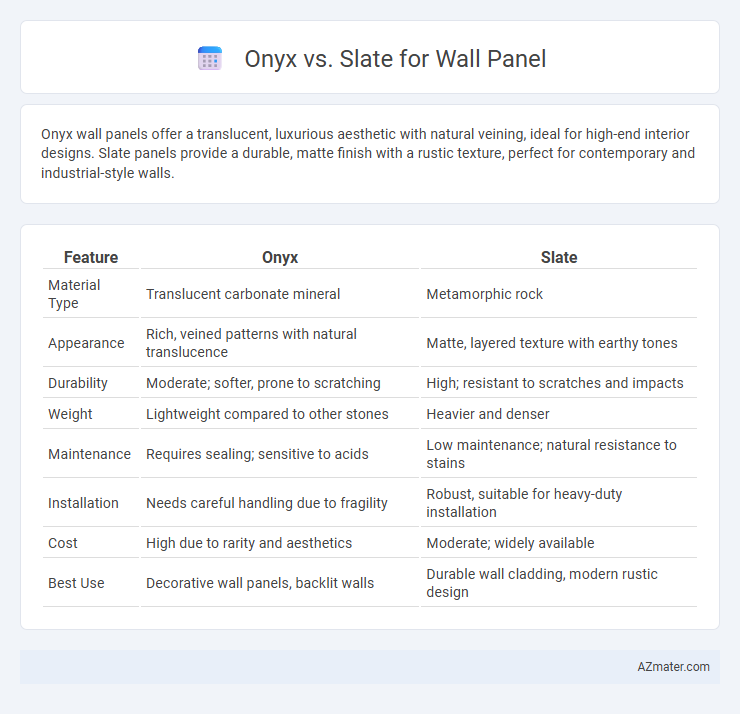Onyx wall panels offer a translucent, luxurious aesthetic with natural veining, ideal for high-end interior designs. Slate panels provide a durable, matte finish with a rustic texture, perfect for contemporary and industrial-style walls.
Table of Comparison
| Feature | Onyx | Slate |
|---|---|---|
| Material Type | Translucent carbonate mineral | Metamorphic rock |
| Appearance | Rich, veined patterns with natural translucence | Matte, layered texture with earthy tones |
| Durability | Moderate; softer, prone to scratching | High; resistant to scratches and impacts |
| Weight | Lightweight compared to other stones | Heavier and denser |
| Maintenance | Requires sealing; sensitive to acids | Low maintenance; natural resistance to stains |
| Installation | Needs careful handling due to fragility | Robust, suitable for heavy-duty installation |
| Cost | High due to rarity and aesthetics | Moderate; widely available |
| Best Use | Decorative wall panels, backlit walls | Durable wall cladding, modern rustic design |
Introduction to Onyx and Slate Wall Panels
Onyx wall panels offer a luxurious, translucent appearance that enhances interior spaces with a natural stone aesthetic and subtle light diffusion. Slate wall panels provide a durable, textured surface known for their rich, deep gray tones and natural cleft finish, ideal for adding rustic elegance and durability. Both materials are favored in architectural design for their distinct visual impact and functional qualities.
Material Composition and Unique Properties
Onyx wall panels are composed primarily of natural calcite crystals, offering translucency that allows for dramatic backlighting effects, enhancing interior aesthetics with a luxurious, glowing appearance. Slate panels consist of fine-grained metamorphic rock rich in quartz and mica, providing exceptional durability, natural cleft texture, and superior resistance to heat and moisture, making them ideal for high-traffic areas. The unique crystalline structure of onyx enables sculptural design possibilities, while slate's dense, foliated composition ensures long-lasting performance and a distinctive matte finish.
Aesthetic Differences: Onyx vs. Slate
Onyx wall panels offer a translucent, luxurious appearance with natural veins that create a striking visual impact, often illuminated to enhance depth and richness. Slate panels exhibit a matte, textured surface with earthy tones that provide a more rustic and rugged aesthetic, ideal for adding natural warmth and character to spaces. The choice between onyx and slate significantly influences the ambiance, with onyx delivering elegance and light play, while slate emphasizes organic, understated sophistication.
Durability and Lifespan Comparison
Onyx wall panels offer superior durability with high resistance to scratches, stains, and impact, making them ideal for high-traffic areas. Slate panels, while durable and naturally robust due to their dense mineral composition, may be more prone to chipping or surface wear over time. The lifespan of Onyx panels typically exceeds 20 years with proper maintenance, whereas Slate can last up to 30 years but requires periodic sealing to preserve its integrity.
Installation Process and Requirements
Onyx wall panels require careful handling due to their translucent and fragile nature, often needing professional installation with backlighting considerations to enhance their visual appeal. Slate wall panels are heavier and denser, demanding secure mounting systems and proper surface preparation to support their weight and prevent moisture damage. Both materials benefit from precise cutting tools and level installation to ensure seamless panel alignment and long-term durability.
Maintenance and Cleaning Tips
Onyx wall panels require careful maintenance due to their porous nature, making regular sealing essential to prevent staining and moisture damage. Slate panels offer superior durability and low maintenance, as their dense structure resists scratches and stains without frequent sealing. To clean both materials effectively, use a pH-neutral cleaner and a soft cloth to avoid surface damage and preserve their natural textures.
Cost Analysis: Onyx vs. Slate
Onyx wall panels typically cost between $50 to $150 per square foot, reflecting their premium appearance and translucency, while slate panels range from $20 to $60 per square foot, offering a more budget-friendly option with natural durability. Installation costs for onyx can be higher due to its delicate nature and need for specialized handling, whereas slate's sturdier composition often results in lower labor expenses. When considering long-term investment, onyx provides a luxurious aesthetic but requires higher maintenance costs compared to slate, which is more cost-effective and resilient for high-traffic areas.
Best Applications for Each Material
Onyx wall panels excel in luxurious interior spaces such as high-end hotels, upscale bathrooms, and feature walls where their translucent properties and vibrant veining create dramatic backlit effects. Slate wall panels are best suited for rustic, outdoor, and high-traffic commercial areas due to their durability, non-porous surface, and natural slip resistance. Selecting onyx enhances aesthetic appeal with sophisticated lighting, while slate prioritizes functionality and ruggedness in demanding environments.
Environmental Impact and Sustainability
Onyx wall panels, composed primarily of natural stone, offer durability but require significant energy for quarrying and processing, contributing to a higher carbon footprint compared to slate. Slate panels, derived from metamorphic rock, are more environmentally sustainable due to lower extraction impact and natural longevity, reducing the need for frequent replacement. Both materials are recyclable; however, slate's minimal processing makes it a more eco-friendly choice for sustainable wall paneling solutions.
Choosing Between Onyx and Slate for Your Walls
Onyx wall panels provide a luxurious, translucent appearance with unique veining patterns that add sophistication and depth to interiors, especially suited for accent walls in upscale settings. Slate panels offer a durable, natural stone texture featuring rich, earthy tones and excellent resistance to moisture and wear, making them ideal for high-traffic or outdoor areas. When choosing between onyx and slate, consider onyx for aesthetic impact and light transmission, while slate is preferred for robustness and a more rustic, organic look.

Infographic: Onyx vs Slate for Wall Panel
 azmater.com
azmater.com